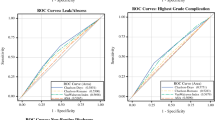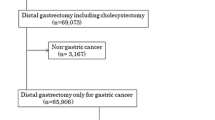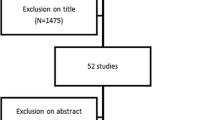Abstract
Background
Patients undergoing laparoscopic Roux-en-Y gastric bypass (LRYGB) often have substantial comorbidities, which must be taken into account to appropriately assess expected postoperative outcomes. The Charlson/Deyo and Elixhauser indices are widely used comorbidity measures, both of which also have revised algorithms based on enhanced ICD-9-CM coding. It is currently unclear which of the existing comorbidity measures best predicts early postoperative outcomes following LRYGB.
Methods
Using the Nationwide Inpatient Sample, patients 18 years or older undergoing LRYGB for obesity between 2001 and 2008 were identified. Comorbidities were assessed according to the original and enhanced Charlson/Deyo and Elixhauser indices. Using multivariate logistic regression, the following early postoperative outcomes were assessed: overall postoperative complications, length of hospital stay, and conversion to open surgery. Model performance for the four comorbidity indices was assessed and compared using C-statistics and the Akaike’s information criterion (AIC).
Results
A total of 70,287 patients were included. Mean age was 43.1 years (SD, 10.8), 81.6 % were female and 60.3 % were White. Both the original and enhanced Elixhauser indices modestly outperformed the Charlson/Deyo in predicting the surgical outcomes. All four models had similar C-statistics, but the original Elixhauser index was associated with the smallest AIC for all of the surgical outcomes.
Conclusions
The original Elixhauser index is the best predictor of early postoperative outcomes in our cohort of patients undergoing LRYGB. However, differences between the Charlson/Deyo and Elixhauser indices are modest, and each of these indices provides clinically relevant insight for predicting early postoperative outcomes in this high-risk patient population.
Similar content being viewed by others
References
Flegal KM, Carroll MD, Ogden CL, et al. Prevalence and trends in obesity among US adults, 1999–2008. JAMA. 2010;303:235–41.
Fisher BL, Schauer P. Medical and surgical options in the treatment of severe obesity. Am J Surg. 2002;184:9S–16S.
McTigue KM, Harris R, Hemphill B, et al. Screening and interventions for obesity in adults: summary of the evidence for the U.S. Preventive Services Task Force. Ann Intern Med. 2003;139:933–49.
Sjostrom L, Narbro K, Sjostrom CD, et al. Effects of bariatric surgery on mortality in Swedish obese subjects. N Engl J Med. 2007;357:741–52.
Buchwald H, Avidor Y, Braunwald E, et al. Bariatric surgery: a systematic review and meta-analysis. JAMA. 2004;292:1724–37.
Flum DR, Dellinger EP. Impact of gastric bypass operation on survival: a population-based analysis. J Am Coll Surg. 2004;199:543–51.
Nguyen NT, Masoomi H, Magno CP, et al. Trends in use of bariatric surgery, 2003–2008. J Am Coll Surg. 2011;213:261–6.
Santry HP, Gillen DL, Lauderdale DS. Trends in bariatric surgical procedures. JAMA. 2005;294:1909–17.
DeMaria EJ, Portenier D, Wolfe L. Obesity surgery mortality risk score: proposal for a clinically useful score to predict mortality risk in patients undergoing gastric bypass. Surg Obes Relat Dis. 2007;3:134–40.
Gupta PK, Franck C, Miller WJ, et al. Development and validation of a bariatric surgery morbidity risk calculator using the prospective, multicenter NSQIP dataset. J Am Coll Surg. 2011;212:301–9.
Turner PL, Saager L, Dalton J, et al. A nomogram for predicting surgical complications in bariatric surgery patients. Obes Surg. 2011;21:655–62.
Finks JF, Kole KL, Yenumula PR, et al. Predicting risk for serious complications with bariatric surgery: results from the Michigan Bariatric Surgery Collaborative. Ann Surg. 2011;254:633–40.
Sjostrom LV. Morbidity of severely obese subjects. Am J Clin Nutr. 1992;55:508S–15S.
Flum DR, Belle SH, King WC, et al. Perioperative safety in the longitudinal assessment of bariatric surgery. N Engl J Med. 2009;361:445–54.
Ballantyne GH, Svahn J, Capella RF, et al. Predictors of prolonged hospital stay following open and laparoscopic gastric bypass for morbid obesity: body mass index, length of surgery, sleep apnea, asthma, and the metabolic syndrome. Obes Surg. 2004;14:1042–50.
Collazo-Clavell ML, Clark MM, McAlpine DE, et al. Assessment and preparation of patients for bariatric surgery. Mayo Clin Proc. 2006;81:S11–7.
Tang J, Wan JY, Bailey JE. Performance of comorbidity measures to predict stroke and death in a community-dwelling, hypertensive Medicaid population. Stroke. 2008;39:1938–44.
Lieffers JR, Baracos VE, Winget M, et al. A comparison of Charlson and Elixhauser comorbidity measures to predict colorectal cancer survival using administrative health data. Cancer. 2011;117:1957–65.
Charlson ME, Pompei P, Ales KL, et al. A new method of classifying prognostic comorbidity in longitudinal studies: development and validation. J Chronic Dis. 1987;40:373–83.
Deyo RA, Cherkin DC, Ciol MA. Adapting a clinical comorbidity index for use with ICD-9-CM administrative databases. J Clin Epidemiol. 1992;45:613–9.
Elixhauser A, Steiner C, Harris DR, et al. Comorbidity measures for use with administrative data. Med Care. 1998;36:8–27.
Southern DA, Quan H, Ghali WA. Comparison of the Elixhauser and Charlson/Deyo methods of comorbidity measurement in administrative data. Med Care. 2004;42:355–60.
Stukenborg GJ, Wagner DP, Connors Jr AF. Comparison of the performance of two comorbidity measures, with and without information from prior hospitalizations. Med Care. 2001;39:727–39.
Quan H, Li B, Saunders LD, et al. Assessing validity of ICD-9-CM and ICD-10 administrative data in recording clinical conditions in a unique dually coded database. Health Serv Res. 2008;43:1424–41.
Quan H, Sundararajan V, Halfon P, et al. Coding algorithms for defining comorbidities in ICD-9-CM and ICD-10 administrative data. Med Care. 2005;43:1130–9.
Agency for Healthcare Research and Quality. Healthcare Cost and Utilization Project. Overview of the Nationwide Inpatients Sample(NIS). 2009. http://www.hcup-us.ahrq.gov/nisoverview.jsp. Accessed 22 Feb 2010.
Healthcare Cost and Utilization Project. Overview of the Nationwide Inpatients Sample (NIS). http://www.hcup-us.ahrq.gov/nisoverview.jsp. Accessed February 2010.
Whalen D, Houchens R, Elixhauser A. 2004 HCUP Nationwide Inpatient Sample (NIS) comparison report. HCUP Method Series Report No. 2007-03. Healthcare Cost and Utilization Project (HCUP) web site. 2006. http://www.hcup-us.ahrg.gov/reports/methods/methods.jsp. Accessed February 2010.
Birkmeyer NJ, Dimick JB, Share D, et al. Hospital complication rates with bariatric surgery in Michigan. JAMA. 2010;304:435–42.
Sokol DK, Wilson J. What is a surgical complication? World J Surg. 2008;32:942–4.
Guller U, Hervey S, Purves H, et al. Laparoscopic versus open appendectomy: outcomes comparison based on a large administrative database. Ann Surg. 2004;239:43–52.
Ricciardi R, Town RJ, Kellogg TA, et al. Outcomes after open versus laparoscopic gastric bypass. Surg Laparosc Endosc Percutan Tech. 2006;16:317–20.
Weller WE, Rosati C. Comparing outcomes of laparoscopic versus open bariatric surgery. Ann Surg. 2008;248:10–5.
Worni M, Guller U, Shah A, et al. Cholecystectomy concomitant with laparoscopic gastric bypass: a trend analysis of the nationwide inpatient sample from 2001 to 2008. Obes Surg. 2012;22:220–9.
Myers RP, Quan H, Hubbard JN, et al. Predicting in-hospital mortality in patients with cirrhosis: results differ across risk adjustment methods. Hepatology. 2009;49:568–77.
Thombs BD, Singh VA, Halonen J, et al. The effects of preexisting medical comorbidities on mortality and length of hospital stay in acute burn injury: evidence from a national sample of 31,338 adult patients. Ann Surg. 2007;245:629–34.
Akaike H. A new look at the statistical model identification. IEEE Trans Autum Control. 1974;19:716–23.
Burnham KP, Anderson DR. Model selection and multimodel inference: a practical information-theoretic approach. New York: Springer; 2002.
Hanley JA, McNeil BJ. A method of comparing the areas under receiver operating characteristic curves derived from the same cases. Radiology. 1983;148:839–43.
Hanley JA, McNeil BJ. The meaning and use of the area under a receiver operating characteristic (ROC) curve. Radiology. 1982;143:29–36.
Erdreich LS, Lee ET. Use of relative operating characteristic analysis in epidemiology. A method for dealing with subjective judgement. Am J Epidemiol. 1981;114:649–62.
Grendar J, Shaheen AA, Myers RP, et al. Predicting in-hospital mortality in patients undergoing complex gastrointestinal surgery: determining the optimal risk adjustment method. Arch Surg. 2012;147:126–35.
Ali MR, Maguire MB, Wolfe BM. Assessment of obesity-related comorbidities: a novel scheme for evaluating bariatric surgical patients. J Am Coll Surg. 2006;202:70–7.
Szomstein S, Avital S, Brasesco O, et al. Laparoscopic gastric bypass in patients on thyroid replacement therapy for subnormal thyroid function—prevalence and short-term outcome. Obes Surg. 2004;14:95–7.
Cunningham JL, Merrell CC, Sarr M, et al. Investigation of antidepressant medication usage after bariatric surgery. Obes Surg. 2012;22:530–5.
Fernandez Jr AZ, Demaria EJ, Tichansky DS, et al. Multivariate analysis of risk factors for death following gastric bypass for treatment of morbid obesity. Ann Surg. 2004;239:698–702.
Perugini RA, Mason R, Czerniach DR, et al. Predictors of complication and suboptimal weight loss after laparoscopic Roux-en-Y gastric bypass: a series of 188 patients. Arch Surg. 2003;138:541–5. discussion 545–546.
Zhang W, Mason EE, Renquist KE, et al. Factors influencing survival following surgical treatment of obesity. Obes Surg. 2005;15:43–50.
Wallace AE, Young-Xu Y, Hartley D, et al. Racial, socioeconomic, and rural–urban disparities in obesity-related bariatric surgery. Obes Surg. 2010;20:1354–60.
Kohn GP, Galanko JA, Overby DW, et al. High case volumes and surgical fellowships are associated with improved outcomes for bariatric surgery patients: a justification of current credentialing initiatives for practice and training. J Am Coll Surg. 2010;210:909–18.
Carbonell AM, Lincourt AE, Matthews BD, et al. National study of the effect of patient and hospital characteristics on bariatric surgery outcomes. Am Surg. 2005;71:308–14.
Poulose BK, Griffin MR, Zhu Y, et al. National analysis of adverse patient safety for events in bariatric surgery. Am Surg. 2005;71:406–13.
Poulose BK, Griffin MR, Moore DE, et al. Risk factors for post-operative mortality in bariatric surgery. J Surg Res. 2005;127:1–7.
Livingston EH, Langert J. The impact of age and Medicare status on bariatric surgical outcomes. Arch Surg. 2006;141:1115–20. discussion 1121.
Conflicts of Interest
All contributing authors, including Jin Hee Shin, Mathias Worni, Anthony W. Castleberry, Ricardo Pietrobon, Philip A. Omotosho, Mina Silberberg, and Truls Østbye, declare that they have no conflicts of interest in relation to this manuscript.
Author information
Authors and Affiliations
Corresponding author
Appendix
Appendix
ICD-9-CM code | |
|---|---|
Postoperative complications | |
Mechanical wound complications | |
Postoperative hematoma | 998.12 |
Postoperative seroma (noninfected) | 998.13 |
Disruption of operative wound | 998.3 |
Disruption of wound unspecified | 998.30 |
Disruption of internal operation (surgical) wound | 998.31 |
Disruption of external operation (surgical) wound | 998.32 |
Persistent postoperative fistula | 998.6 |
Delayed wound healing | 998.83 |
Infections | |
Postoperative infection | 998.5 |
Postoperative infected seroma | 998.51 |
Postoperative skin abscess/infection | 998.59 |
Postoperative septic wound complications | 998.59 |
Postoperative intraabdominal/subdiaphragmatic abscess | 998.59 |
Urinary/renal complications | |
Postoperative urinary retention | 997.5 |
Postoperative urinary tract infection | 997.5 |
Acute renal failure | 997.5 |
Pulmonary complications | |
Postoperative acute pneumothorax | 512.1 |
Postoperative pulmonary edema | 518.4 |
Adult respiratory distress syndrome following surgery | 518.5 |
Transfusion-related acute lung injury | 518.7 |
Postoperative atelectasis/pneumonia | 997.3 |
Mendelson syndrome resulting from a procedure | 997.3 |
Gastrointestinal complications | |
Postoperative vomiting | 564.3 |
Diarrhea following gastrointestinal surgery | 564.4 |
Postoperative small bowel obstruction/ileus (requiring nasogastric tube) | 997.4 |
Complication of anastomosis of gastrointestinal tract | 997.4 |
Cardiovascular complications | |
Postoperative hypotension | 458.29 |
Postoperative stroke | 997.02 |
Cardiac arrest/insufficiency during or resulting from a procedure | 997.1 |
Phlebitis or thrombophlebitis from procedure | 997.2 |
Systemic complications | |
Postoperative shock | 998.0 |
Postoperative fever | 998.89 |
Unspecified complication of procedure, not elsewhere classified | 998.9 |
Rights and permissions
About this article
Cite this article
Shin, J.H., Worni, M., Castleberry, A.W. et al. The Application of Comorbidity Indices to Predict Early Postoperative Outcomes After Laparoscopic Roux-en-Y Gastric Bypass: A Nationwide Comparative Analysis of Over 70,000 Cases. OBES SURG 23, 638–649 (2013). https://doi.org/10.1007/s11695-012-0853-3
Published:
Issue Date:
DOI: https://doi.org/10.1007/s11695-012-0853-3




